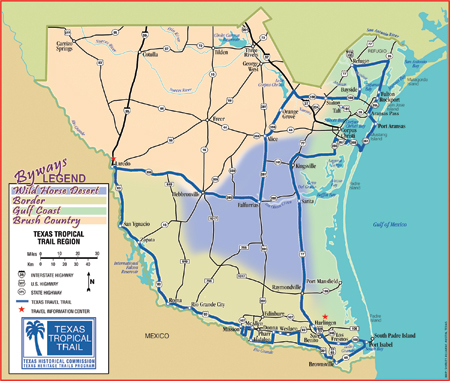So what is the Brush Country anyway?
This year is the sesquicentennial of St. Francis de Paula parish in San Diego. Sesquicentennial is another way to say, the 150th anniversary. I first heard the term when Texas celebrated its sesquicentennial and thought it sounded pretentious. Still do.
But I digress.
I thought it would be a great time to publish a book on the history of the parish. Still do, but am not sure I could do it in the remaining nine months. Still, I was discussing the project with a friend and mentioned that I already had a title: “St. Francis de Paula, Mother Church of the Brush Country.” She suggested I check this out, because there may be older churches in the Brush Country.
That got me to thinking. What is the Brush Country anyway? What counties would make up this area? I have always thought of the Brush Country as Duval, Jim Hogg, Brooks, and Jim Wells Counties. If I am correct, there is no doubt that St. Francis is the mother church of the Brush Country.
This is how Texas Parks and Wildlife Department describes the Brush Country: “East of the Rio Grande River and south of the Balcones Escarpment lies a relatively unpopulated region known as the South Texas Brush Country.”
That is quite an area, but forgive me if I take a slight issue with this very capable state agency. This large area includes one of the state’s largest cities. I can hardly describe the San Antonio River in downtown San Antonio as a brushy area. And many parts in this area, I would call by different names. For example, the Rio Grande Valley, the Coastal Bend, the Winter Garden, etc.
The term Brush Country was actually popularized by noted South Texas author J. Frank Dobie in his book A Vaquero of the Brush Country: The Life and Times of John D. Young. In a 1928 article appearing in the Southwest Review entitled “In the Brush Country” Dobie describes the area as including Webb, McMullen, Live Oak, Duval and “other south Texas counties” between the Rio Grande and the Nueces River. To his credit, Dobie acknowledged that “Mexicans” had recognized this area as la brasada for some time. The definition of the Brush Country is highly influenced by the vegetation that is found there; mostly “thorned” underbrush. The ramadero consisting of mesquite, huisache, agrito, granjeno, nopal, etc. dot the landscape.
While this list of counties is closer to what I envisioned, it is not quite there. Let us explore which “other South Texas counties” Dobie may have imagined. Well, I like the ones that are singled out by the Texas Tropical Trail, which breaks the South Texas region into four “byways”. These include the Border Byway, along the Rio Grande, the Gulf Coast Byway along the Texas Gulf Coast. In between are the Brush Country Byway and the Wild Horse Desert Byway.
The Brush Country Byway is said to include the counties of Brooks, Duval, Dimmit, Jim Hogg, Jim Wells, La Salle, Live Oak, McMullen and Webb. Dimmit, Lasalle and Webb are also described as being part of the Winter Garden Region, along with Frio, Zavala and parts of Atascosa, Maverick, and McMullen. So removing the Winter Garden counties from the Brush Country Byway, we are left with Brooks, Duval, Jim Hogg, Jim Wells, Live Oak and parts of McMullen, the southern part that borders Duval and Live Oak.
So for the purposes of my book, these counties are in what I term the Brush Country. All are in what was historically the Diocese of Corpus Christi and all Catholic churches in those counties, with the possible exception of McMullen and perhaps Live Oak were offshoots of St. Francis de Paula. While Father Pedro Bard evangelized in Live Oak early, at this point I am not certain whether his efforts led directly to the establishment of the present churches in that county.
Kind of a roundabout way to get to where I thought I was at the beginning but it was a worthwhile exercise.





Great information, thank you for the service you do in preserving our Tejano history!
Thank you.
Thank you for your historical information and how cleverly you wrote it to the very end! I loved the picture too. Good luck in your endeavor with your book.
Thank you.
Alfredo;
Did you ever find anything ab out the “Sacred Heart Parish?”
Not yet. Thanks for asking.
I’ve always considered myself a ‘brush’ guy. In my mind, the center of the brush country IS Webb and Duval. But I don’t necessarily equate la brasada as the limits of brush country. I would go at least to San Antonio and beyond Del Rio, and all the valley and coast, too. It’s where the brush is. IMHO.
…the term “la brasada” is a Tejano word spoken more or less in the areas Mr. Cardenas mentioned. It was first used in the 1680s if not before. It does NOT include San Antonio or Del Rio. One of the first official documents referring to la brasada was a Spanish map of this area dated 1690.
I am also a writer and historical researcher, born and raised in Duval County in Freer. Currently; I am working on a book, “San Antonio’s Historic Market Square.” Love our local history! Saludos, Edna Campos Gravenhorst
I was born and raised in Alice, Jim Wells, Texas and although I moved away in 1963, my roots remain in the “brush country”. Incidentally, Ft Peter Bard married my grandparents in April 1894 and baptized my father and most, if not all, of his siblings. I was able to get copies of some of the sacrament papers when I visited the church several years ago. So, I would be interested in reading anything you write about that area. Thank you.
Thank you Fannie. Your family’s experience with Father Bard was often repeated as he touched thousands of lives.